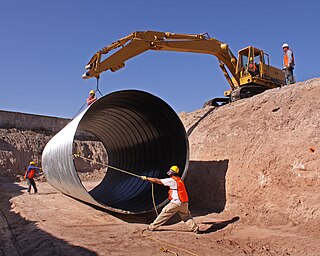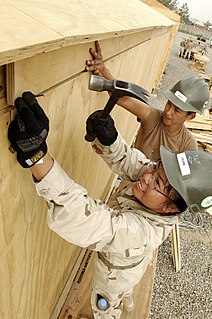
The National Workers Memorial in the national capital, Canberra, Australian Capital Territory, is Australia's place for honouring workers who have died as a result of work-related accidents, incidents and disease.

The National Workers Memorial in the national capital, Canberra, Australian Capital Territory, is Australia's place for honouring workers who have died as a result of work-related accidents, incidents and disease.
In May 2011, the Australian Government provided funding for the design and construction of a memorial "to honour and pay tribute to working Australians who have died as a result of work-related accidents, incidents and disease". [1] The other stated purposes are:
Workplace deaths amount to around 300 per year in Australia. [2]
The site in Canberra is within the sound of the bells of the National Carillon, in Kings Park, Canberra, beside Lake Burley Griffin. The other memorials nearby are:
The memorial has been sanctioned by the National Capital Authority as the memorial is within the Parliamentary Triangle of Canberra. [3] [4]
The memorial consists of eight tall stone poles, symbolically sighted across a stylised map of Australia in the places of the state and territory capital cities. Architectural firm Johnson Pilton Walker [5] has placed concentric circles around the poles with words representing the intended outcome of knowledge and application of good practices of work health and safety.
The lead-in path has two inscriptions along its edge, saying:
The inauguration ceremony was held on Sunday 28 April 2013. [2]

Workers' compensation and often abbreviated as Workers' Comp, is a form of insurance providing wage replacement and medical benefits to employees injured in the course of employment in exchange for mandatory relinquishment of the employee's right to sue his or her employer for the tort of negligence. The trade-off between assured, limited coverage and lack of recourse outside the worker compensation system is known as "the compensation bargain." One of the problems that the compensation bargain solved is the problem of employers becoming insolvent as a result of high damage awards. The system of collective liability was created to prevent that, and thus to ensure security of compensation to the workers. Individual immunity is the necessary corollary to collective liability.

The Occupational Safety and Health Act of 1970 is a US labor law governing the federal law of occupational health and safety in the private sector and federal government in the United States. It was enacted by Congress in 1970 and was signed by President Richard Nixon on December 29, 1970. Its main goal is to ensure that employers provide employees with an environment free from recognized hazards, such as exposure to toxic chemicals, excessive noise levels, mechanical dangers, heat or cold stress, or unsanitary conditions. The Act created the Occupational Safety and Health Administration (OSHA) and the National Institute for Occupational Safety and Health (NIOSH).

A work accident, workplace accident, occupational accident, or accident at work is a "discrete occurrence in the course of work" leading to physical or mental occupational injury. According to the International Labour Organization (ILO), more than 337 million accidents happen on the job each year, resulting, together with occupational diseases, in more than 2.3 million deaths annually.
An occupational injury is bodily damage resulting from working. The most common organs involved are the spine, hands, the head, lungs, eyes, skeleton, and skin. Occupational injuries can result from exposure to occupational hazards, such as temperature, noise, insect or animal bites, blood-borne pathogens, aerosols, hazardous chemicals, radiation, and occupational burnout.
Construction work is a hazardous land-based job. Some construction site jobs include: building houses, roads, tree forts, workplaces and repair and maintain infrastructures. This work includes many hazardous task and conditions such as working with height, excavation, noise, dust, power tools and equipment. The most common fatalities are caused by the fatal four: falls, being struck by an object, electrocutions, and being caught in between two objects. Construction work has been increasing in developing and undeveloped countries over the past few years. With an increase in this type of work occupational fatalities have increased. Occupational fatalities are individuals who die while on the job or performing work related tasks. Within the field of construction it is important to have safe construction sites.
The Royal Canberra Hospital implosion was a failed building implosion that killed one person and injured nine others. The implosion occurred on 13 July 1997, when the city's superseded hospital buildings at Acton Peninsula on Lake Burley Griffin were demolished to make way for the National Museum of Australia.

The National Carillon, situated on Aspen Island in central Canberra, Australia is a large carillon managed and maintained by the National Capital Authority on behalf of the Commonwealth of Australia.

Kings Park is a park in Canberra, Australia on the shore of Lake Burley Griffin.
The National Day of Mourning, or Workers’ Mourning Day is observed in Canada on 28 April. It commemorates workers who have been killed, injured or suffered illness due to workplace related hazards and occupational exposures.
Workers' Memorial Day, International Workers' Memorial Day or International Commemoration Day (ICD) for Dead and Injured or Day of Mourning takes place annually around the world on April 28, an international day of remembrance and action for workers killed, disabled, injured or made unwell by their work.

An occupational hazard is a hazard experienced in the workplace. Occupational hazards can encompass many types of hazards, including chemical hazards, biological hazards (biohazards), psychosocial hazards, and physical hazards. In the United States, the National Institute for Occupational Safety and Health (NIOSH) conduct workplace investigations and research addressing workplace health and safety hazards resulting in guidelines. The Occupational Safety and Health Administration (OSHA) establishes enforceable standards to prevent workplace injuries and illnesses. In the EU a similar role is taken by EU-OSHA.

Around the world, nearly 250 million children, about one in every six children, ages 5 through 17, are involved in child labor. Children can be found in almost any economic sector. However, at a global level, most of them work in agriculture (70%). Approximately 2.4 million adolescents aged 16 to 17 years worked in the U.S. in 2006. Official employment statistics are not available for younger adolescents who are also known to work, especially in agricultural settings.
Comcare is a statutory authority of the Australian Federal Government established under the Safety, Rehabilitation and Compensation Act 1988 and covered by the Commonwealth Authorities and Companies Act 1997. Comcare administers the Commonwealth's workers' compensation scheme under the SRC Act; and the Work Health and Safety Act 2011.
Workplace health surveillance or occupational health surveillance (U.S.) is the ongoing systematic collection, analysis, and dissemination of exposure and health data on groups of workers. The Joint ILO/WHO Committee on Occupational Health at its 12th Session in 1995 defined an occupational health surveillance system as “a system which includes a functional capacity for data collection, analysis and dissemination linked to occupational health programmes”.
On June 29, 2008, the XVIII World Congress on Safety and Health at Work signed the Seoul Declaration on Safety and Health at Work. The declaration included statements concerning national governments' responsibility for perpetuating a "national preventive safety and health culture", for improving their national safe-workplace performance systematically, and for providing a health standard with appropriate enforcement to protect workers. The declaration also listed responsibilities of employers, stated the rights of workers, and emphasized the importance of promoting a culture of safety.
An occupational fatality is a death that occurs while a person is at work or performing work related tasks. Occupational fatalities are also commonly called “occupational deaths” or “work-related deaths/fatalities” and can occur in any industry or occupation.

A physical hazard is an agent, factor or circumstance that can cause harm without contact. They can be classified as type of occupational hazard or environmental hazard. Physical hazards include ergonomic hazards, radiation, heat and cold stress, vibration hazards, and noise hazards. Engineering controls are often used to mitigate physical hazards.

Occupational safety and health (OSH), also commonly referred to as health and safety, occupational health and safety (OHS), occupational health, or occupational safety, is a multidisciplinary field concerned with the safety, health, and welfare of people at work. These terms also refer to the goals of this field, so their use in the sense of this article was originally an abbreviation of occupational safety and health program/department etc.
The law for workplace bullying is given below for each country in detail. Further European countries with concrete antibullying legislation are Belgium, France, and The Netherlands.

Agricultural safety and health is an aspect of occupational safety and health in the agricultural workplace. It specifically addresses the health and safety of farmers, farm workers, and their families.
| Wikimedia Commons has media related to National Workers Memorial (Australia) . |